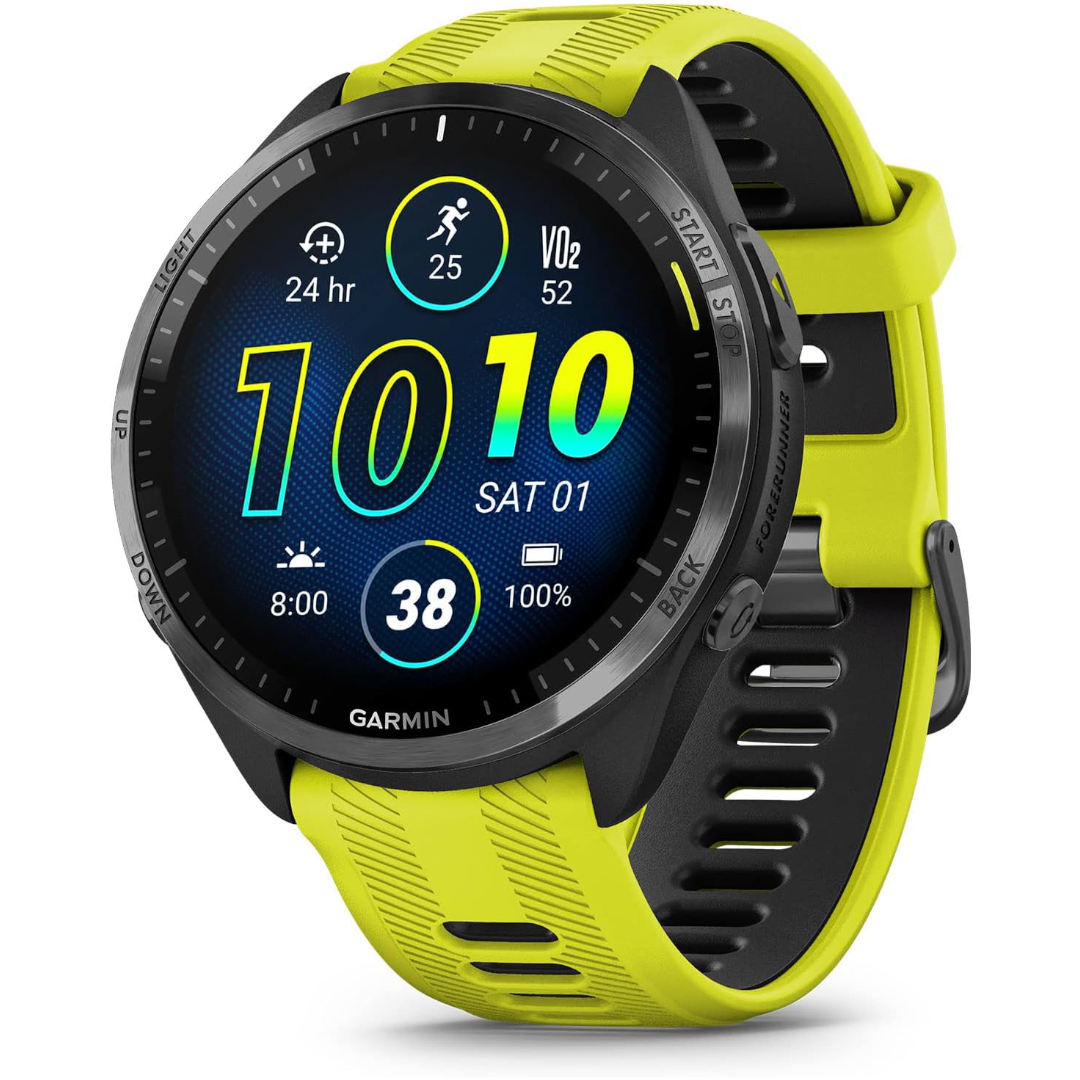
Best you can buy
Whether you’re a serious athlete or just an avid running hobbyist looking to improve, the Forerunner 965 holds nothing back. It has all the best running tools Garmin has to offer, with the promise of years of future updates to keep things fresh. You may not need its topographical maps or outdoor sports profiles, but they’re nice to have.
For
- Has every perk the 265 offers
- Full-color topographical maps
- Superior battery & larger display
- Endurance/ Hill scores & real-time stamina
- 21 extra activity modes like golf
Against
- Slightly thicker, heavier
- Only one size w/ no Quick Release bands
- Quite costly
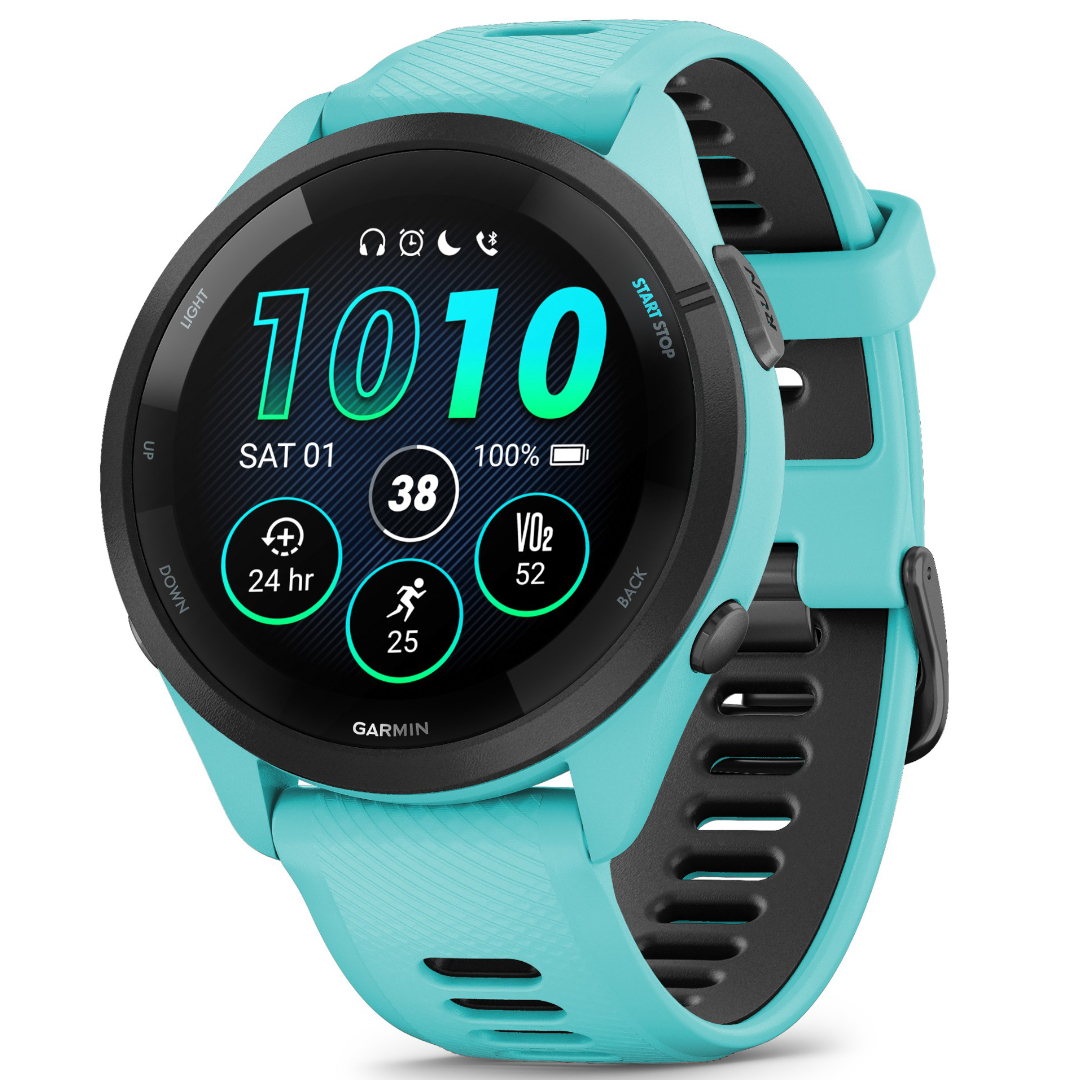
All the essentials, and more
This is a more “reasonable” Garmin watch: It’s mostly plastic, lasts a couple of weeks per charge, and costs about the same as other mid-range watches like the Venu 3 or Instinct 2X Solar. Despite this, you’re still getting dual-band GPS, training readiness, race-adaptive training plans and workout suggestions, and other tools and metrics that no other running watch brand offers.
For
- Same GPS & sensors for more reasonable price
- Training Readiness & workout recs
- Dual-band GPS
- Comes in two sizes, both lighter
- Quick-release bands
Against
- Battery life could be better
- No pre-downloaded maps
- Plastic bezel
If you need a watch for your couch-to-5K journey or the occasional jog, neither of these watches are for you. The Forerunner 265 is a serious running watch that sacrifices other amenities to focus on battery life and training tools above all else. The Forerunner 965 fixes some of the 265’s compromises, but at a price point that only serious runners should contemplate paying.
As the person who reviewed the Forerunner 965 and the Forerunner 265 in quick succession, I’m well placed to determine just how much of an upgrade the 965 is. It’s still my daily watch months later, but if I’d stuck with the 265 and never tried it, I’m sure I would have been perfectly happy…without knowing what I was missing!
Garmin Forerunner 965 vs. 265: What’s the same?
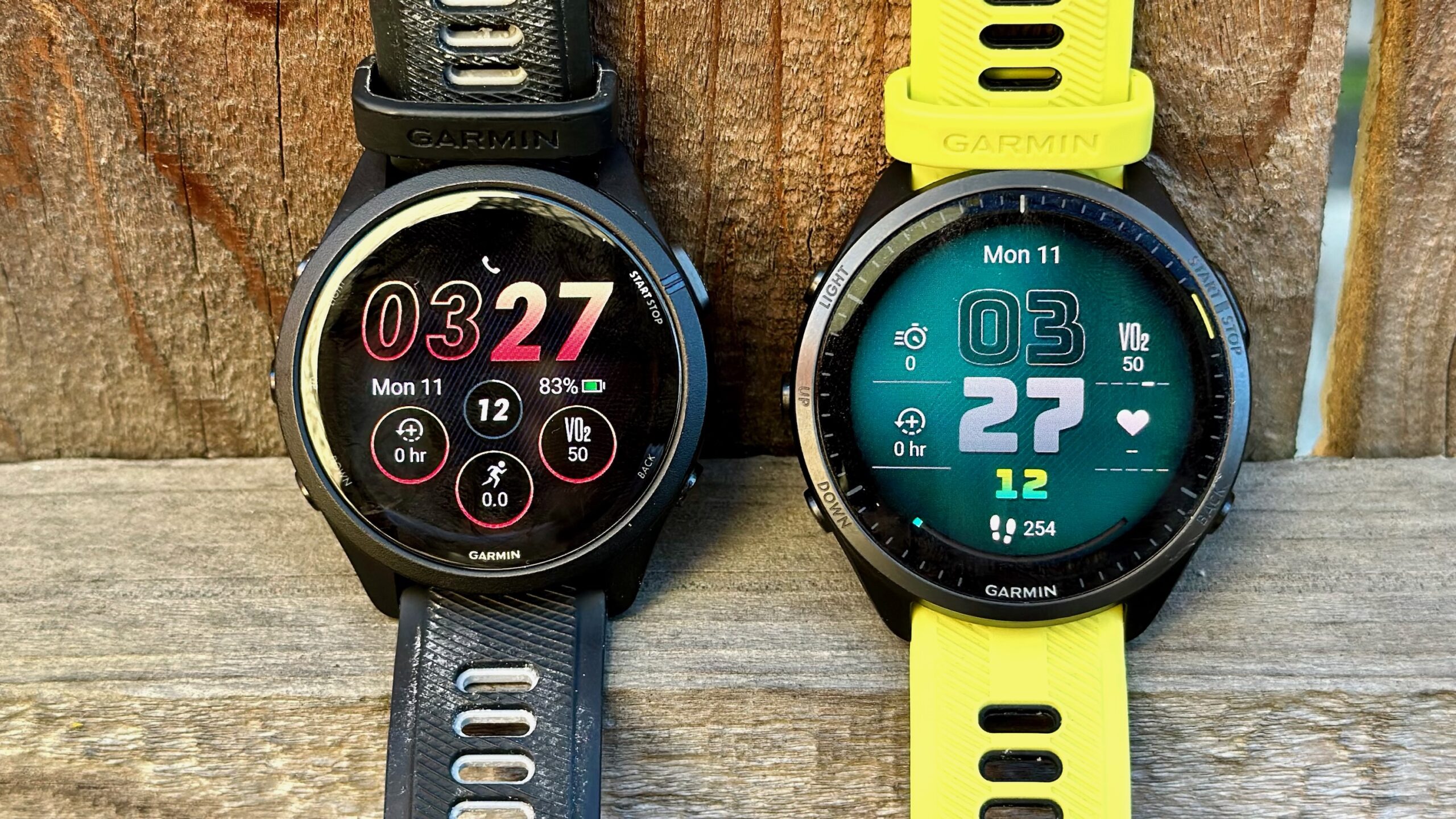
Launched in the same month, the Forerunner 965 and 265 share most of the same tricks by design. The pricier running watch has exclusives, while the mid-range option is no slouch. I’ll go into specific changes below, but these are the main similarities:
AMOLED displays: After years of MIP displays, Garmin gave the Forerunner 265 and 965 AMOLED displays for the first time. While the 965 display is bigger, their pixel-per-inch ratio is nearly the same: the 965 PPI is 324, the 265 PPI is 320, and the 265S PPI is 327.
Dual-band GPS and SatIQ: With either watch, you can use different location accuracy settings that balance precision with battery life. All-systems mode uses multiple GNSSs like GPS and GLONASS at once, depending on what’s around; dual-band GPS uses both L1 and L5 frequencies to bypass signal blockages from different angles; and SatIQ mode switches between options automatically depending on how much extra satellite help you need, saving battery while still offering good accuracy.
You can choose the 965 or 265 to get more reliable GPS than any other brand; in fact, the Forerunner 255 and 955 also offer dual-band GPS, though not SatIQ mode. I’ve extensively tested the accuracy of each watch, and I’ve never been disappointed thus far.
Core Garmin smarts: As with most high-end Garmin watches, you get Garmin Pay (NFC), ANT+ connectivity, wi-fi downloads, music storage (though the 965 has more), Livetrack safety features, Sleep Score with nap detection, phone notifications with visible photos, and quick replies (though the latter two are Android-only).
Unlike the Venu 3, which I reviewed most recently, neither gives you a mic, speaker, or Sleep Coaching. Both Forerunners did steal some of its UI upgrades in the December update, though.
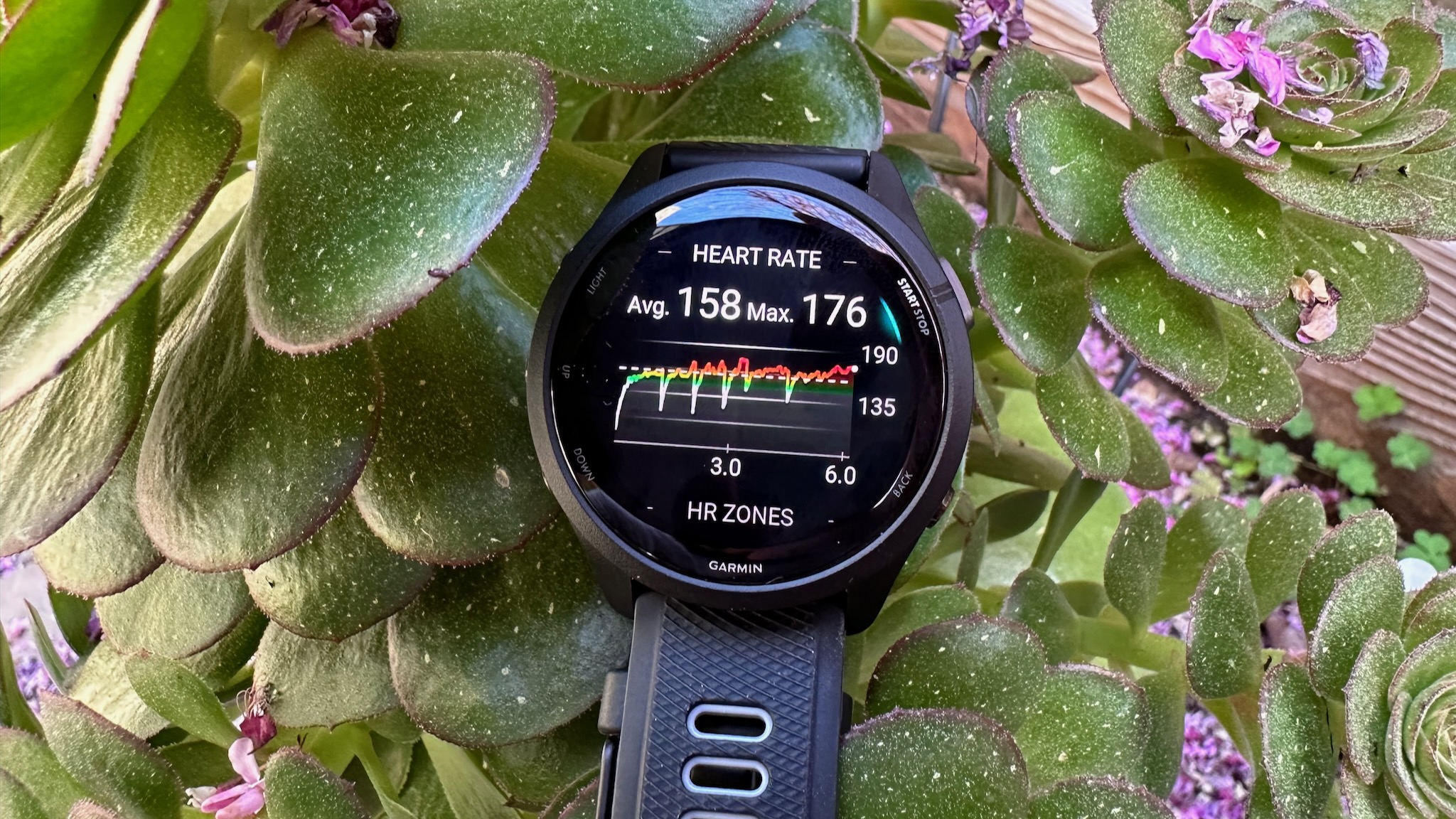
Sensors: Whichever Forerunner you buy, you get an Elevate v4 heart rate sensor — meaning no 5th-Gen ECG or skin temperature — blood oxygen, altimeter for elevation, compass for navigation, accelerometer and gyroscope for movement detection and running form analysis, and an ambient light sensor to automatically adjust AMOLED brightness.
The lack of AFib detection and skin temperature is a downside to both, one you can rectify by choosing the Venu 3. But as our Venu 3 vs. Forerunner 265 breakdown shows, the Venu lineup is missing many of the great running tools I’ll list next.
Training and metrics: Get ready for an absurd laundry list of features. The Garmin Forerunner series has a well-earned reputation for guiding runners to success, and these two watches have virtually all of the same tricks.
Our Garmin Forerunner guide compares all of the Forerunners’ software similarities and differences; for the Garmin Forerunner 965 vs. 265 specifically, these are the training, metrics, and health features that both share:
| Training guidance | VO2 Max, fitness age, Garmin Coach, daily workout suggestions, Morning Report, race adaptive training plans, Pacepro, Training Status, Training Readiness, recovery time |
| Training metrics | Intensity minutes, wrist-based running dynamics (form), running power, training effect, training load, training load focus, acute load, Performance Condition, race predictor |
| Health tracking | Continuous heart rate, SpO2, Body Battery, HRV status, Sleep Score, Stress tracking, Relaxation reminders, Move alerts, Hydration log, women’s health log, Health Snapshot |
| Activity profiles | Running, Outdoor Track Running, Trail Running, Ultra Running, Treadmill Running, Indoor Track Running, Virtual Running, Triathlon, Walking, Pilates, Yoga, Strength, HIIT, Cardio, Elliptical Training, Stair Stepping, Floor Climbing, Indoor Rowing, Hiking, Biking, Mountain Biking, eBiking, eMountain Biking, Indoor Biking, Pool Swimming, Open Water Swimming, Stand Up Paddleboarding, Rowing, Tennis, Pickleball, Badminton, Squash, Table Tennis, Padel, Platform Tennis, Racquetball, Skiing, Snowboarding, XC Classic Skiing, Basketball, Volleyball, Field Hockey, Ice Hockey, Football/Soccer, American Football, Lacrosse, Rugby, Ultimate Disc, Cricket, Softball, Baseball, Boxing, Mixed Martial Arts, Inline skating |
There’s a reason why the Garmin Forerunner 265 is our pick for the best running watch today. The Forerunner 965 is undoubtedly better, but just look at all of the features above that the Forerunner 265 offers, too! Unless you specifically need the 965-exclusive tools I’ll outline in later sections, you can absolutely make do with the Forerunner 265 software suite and improve as a runner.
Garmin Forerunner 965 vs. 265: Design and display
| Category | Garmin Forerunner 965 | Garmin Forerunner 265 / 265S |
|---|---|---|
| Display | 1.4-inch (454×454) AMOLED touchscreen | 1.3-inch (416×416) or 1.1-inch (360×360) AMOLED touchscreen |
| Material | Fiber-reinforced polymer | Fiber-reinforced polymer |
| Bezel | Titanium | Polymer |
| Dimensions | 47.2 x 47.2 x 13.2mm | 46.1 x 46.1 x 12.9mm; 41.7 x 41.7 x 12.9mm |
| Weight | 53g | 47g; 39g |
| Bands | 22mm QuickFit | 22mm or 18mm Quick Release |
| Protection | 5ATM; Gorilla Glass 3 DX | 5ATM; Gorilla Glass 3 |
Both of these watches have the same signature Garmin Forerunner look; they’re more functional than stylish, sticking out fairly noticeably from your wrist. They also have 5ATM water resistance, so you can keep wearing them for your pool activities.
I wish that Garmin sold a Forerunner 965S to appeal to small-wristed runners. But that minor quibble aside, the 1.4-inch Forerunner 965 has a better design than the 1.3-inch 265 — with one exception.
Even though the Forerunner 965 has a bigger case (47mm vs. 46mm), it only weighs 6g more. 53g, or 1.87oz, is heavier than some fitness watches but not painfully so, since that number incorporates the band. You feel it initially but lose awareness of it during a run; the same goes for the 47g Forerunner 265, which doesn’t feel all that different in practice. You’ll want the 39g Forerunner 265S if weight is a real concern.
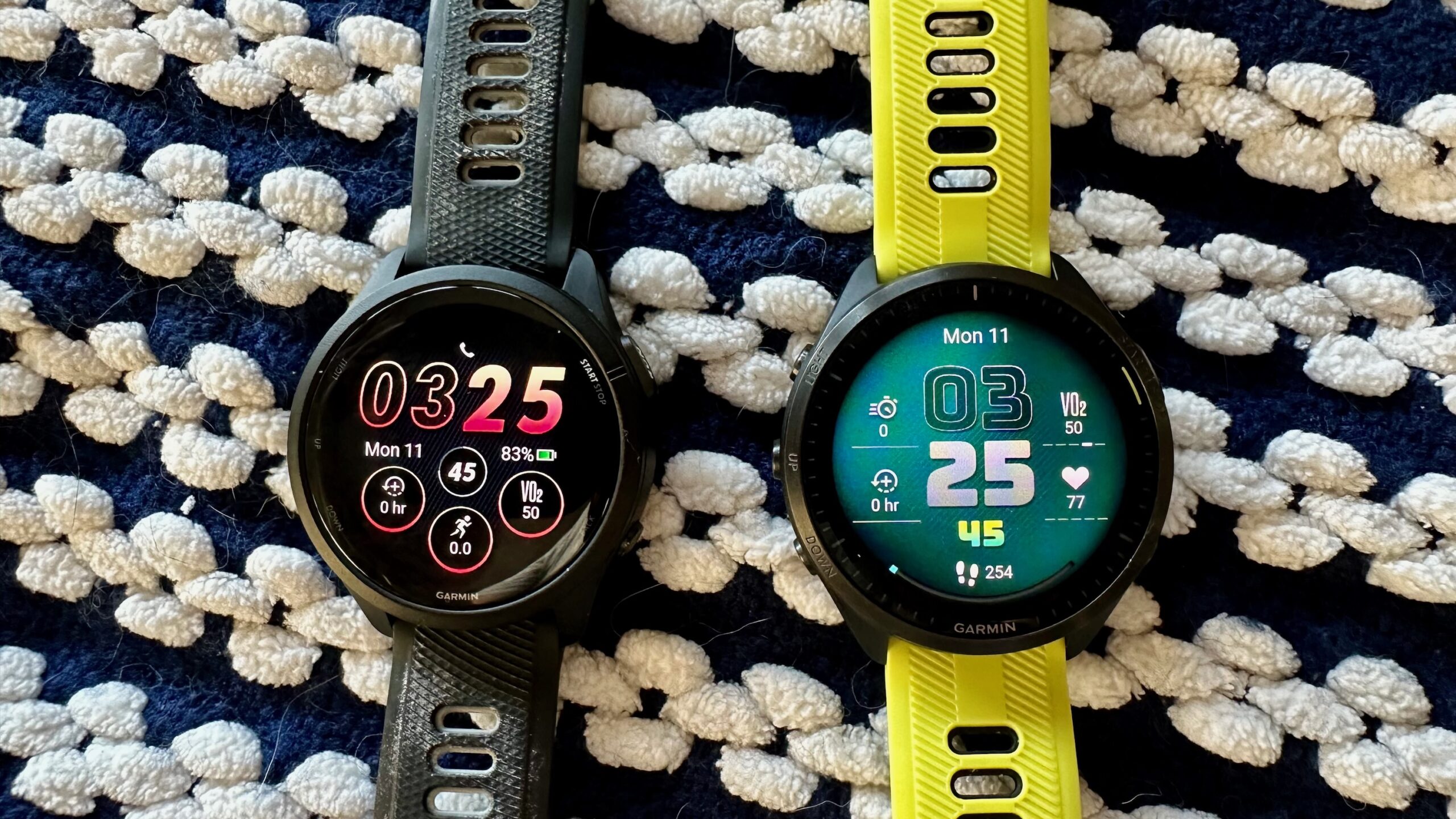
Looking at each watch from the top down, the Forerunner 265’s plastic bezel looks like it sits awkwardly on top of the AMOLED display, while the Forerunner 965’s titanium bezel encases it in a more natural and stylish way. The latter still mostly relies on plastic, but that helps keep it light; if you want a better titanium finish, you’ll need a Garmin Epix Pro Gen 2, which costs much more and weighs a whopping 98g for the 1.4-inch watch.
Another perk of the Forerunner 965 is its Gorilla Glass 3 DX finish. Corning notes that it has a 75% better anti-reflective coating and 50% better color contrast than its standard GG 3 finish, which the 265 uses. It makes the Forerunner 965 easier to read in sunny conditions, or even indoors, where the 265 frequently shows reflections along the display edge. I also noted that the 265 can “accentuate my finger oil smudges” more than the 965 in my review.
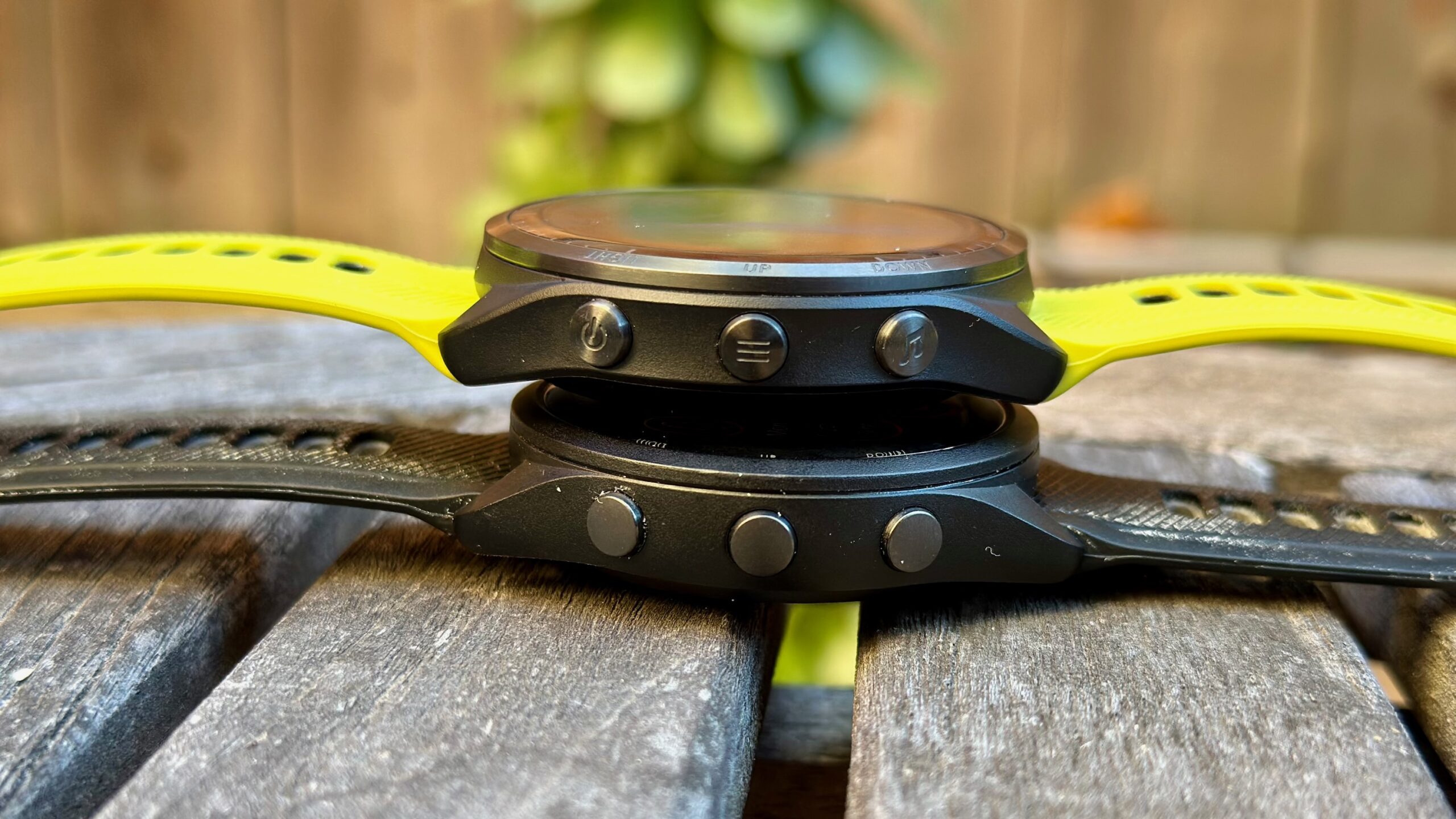
Flipping the script, the Forerunner 265 uses Quick Release bands that let you pull a tab to remove them in seconds, making them easy to swap out or clean.
For the Forerunner 965, Garmin used QuickFit, a somewhat misleading name because you need a special tool or a screwdriver just to remove its bands. You can do it, but fair warning that you’ll probably end up sticking with the default strap out of laziness.
Garmin Forerunner 965 vs. 265: Hardware and battery life
| Category | Garmin Forerunner 965 | Garmin Forerunner 265 |
|---|---|---|
| Sensors | Elevate v4 HRM; Pulse Ox, accelerometer; ambient light sensor; barometric altimeter; compass; gyroscope | Elevate v4 HRM; Pulse Ox, accelerometer; ambient light sensor; barometric altimeter; compass; gyroscope |
| GNSS | GPS, GLONASS, GALILEO | GPS, GLONASS, GALILEO |
| Accuracy modes | All-Systems GNSS; dual-band GPS; SatIQ mode | All-Systems GNSS; dual-band GPS; SatIQ mode |
| Connectivity | Garmin Pay (NFC), Bluetooth, ANT+, Wi-Fi | Garmin Pay (NFC), Bluetooth, ANT+, Wi-Fi |
| Music storage | 32GB | 8GB |
| Battery (Smartwatch) | 23 days | 265: 13 days; 265S: 15 days |
| Battery (GPS only) | 31 hours | 265: 20 hours; 265S: 24 hours |
| Battery (SatIQ mode) | 22 hours | 265: 16 hours; 265S: 18 hours |
| Battery (dual-frequency) | 19 hours | 265: 14 hours; 265S: 15 hours |
As I already explained above, the Garmin Forerunner 965 and 265 share the same health sensors, tracking sensors, connectivity tools, and satellite functionality. They’ll both connect to ANT+ accessories, heart rate monitor straps, and (for cyclists) power meters and Varia radar/ lights.
The only hardware difference worth noting is that the Garmin Forerunner 965 has 32GB of storage instead of 8GB. You might assume that means you get quadruple the music storage, but remember that Garmin primarily gives you that space for map storage. By default, your continent’s topographical maps will probably claim about 10GB; you can also buy and download maps in other areas.
Otherwise, the key distinction between them is battery life. The Forerunner 965 has excellent battery life, beating the MIP Forerunner 955 by days for idle battery even if it loses for GPS battery. In our review testing, it held up to Garmin’s estimates, needing infrequent charging even while tracking dual-frequency runs or GPS-only walks every day.
The Forerunner 265 doesn’t have the same longevity, although the 265S does surprisingly better in every category. If you can stomach the smaller display, that might be a compromise worth buying if you really want to avoid frequent charging or your watch dying during long runs.
From my experience testing both watches for long stretches, the Forerunner 265 will last a week, give or take a day, if you’re a runner or cyclist using dual-band GPS for daily training. With the Forerunner 965, you’re liable to get closer to two weeks.
Exclusive Garmin Forerunner 965 features
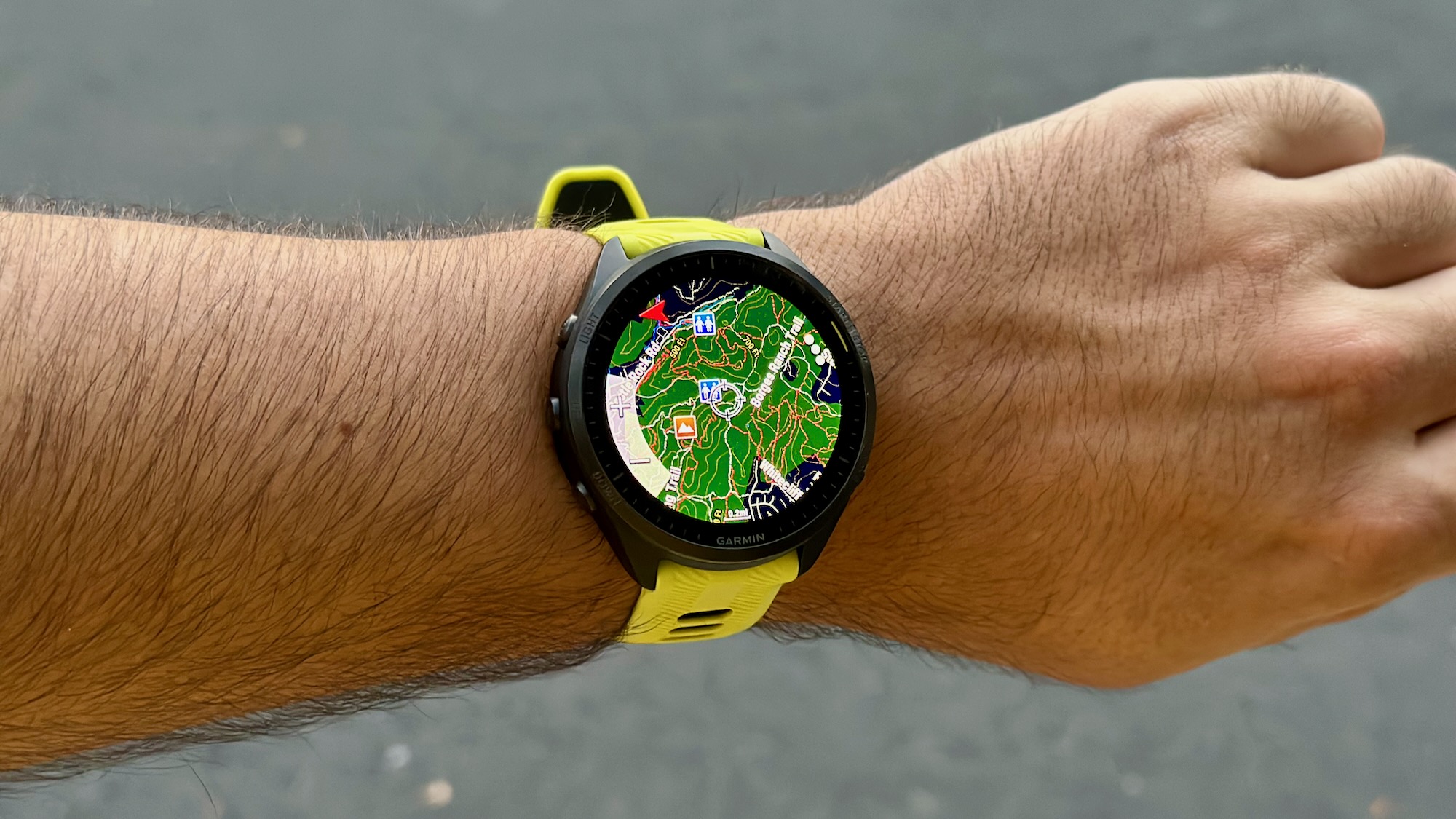
Let’s run through all of the key Garmin Forerunner 965 features the 265 lacks, and see if you can live without them, starting with the biggest one: Maps.
You can download courses to the Forerunner 265, with the ability to route yourself back to where you started, see what’s ahead or how far you have to go or check the total elevation changes across your route. But the key is that you have to download stuff ahead of time, or else your map is just a line on top of a blank canvas. It doesn’t have the storage for full topographical maps.
With the Forerunner 965, you have that pre-downloaded map data so you can check for nearby trail paths and find your way home more naturally. You get a ClimbPro ascent planner to know what elevation gains are coming, an “Around Me” mode to find the nearest restroom or landmark, and a NextFork tool to tell you where the nearest trail junction is on your current path.
Frankly, I don’t use this feature that often because I mostly run on familiar trails around my home. It’s only necessary if you like to do a lot of hiking or long bike rides in unfamiliar locations. Still, it’s very nice to have in a hiking or trail run emergency.
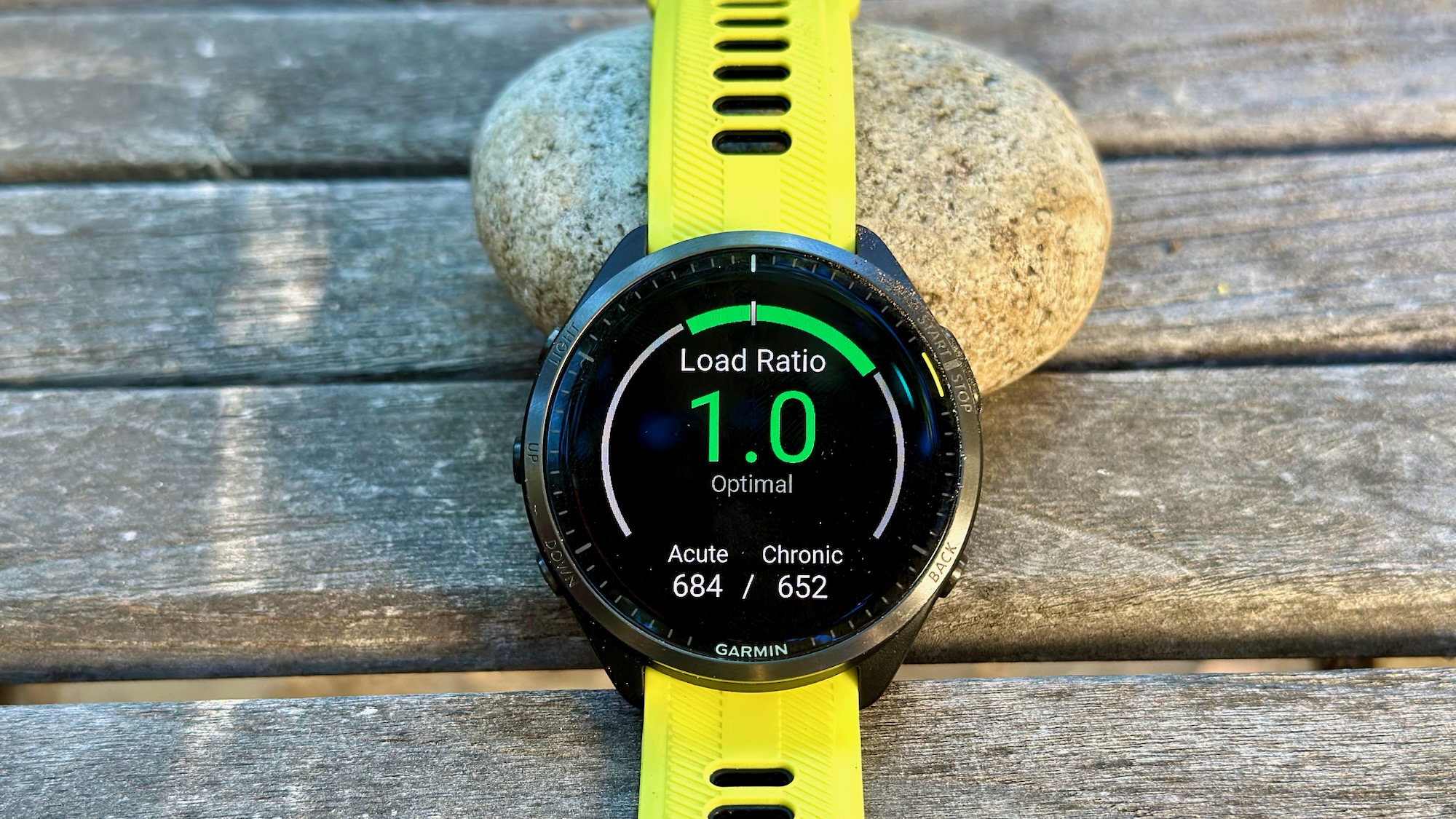
Next, let’s run through specific training tools. The Forerunner 965 uses your training readiness, VO2 Max, Body Battery, and other data to give you a “real-time stamina” widget during your run. It estimates how much energy you have left before you’re likely to need to stop, so you know when to turn around.
Although the Forerunner 265 shows your current acute load — your seven-day training load and whether it falls into your optimal fitness range — only the Forerunner 965 has chronic load and training load ratio. Essentially, it compares your current weekly load against your averages for the past four weeks; the hope is that you keep your load ratio slightly higher than 1.0 to steadily improve your fitness over time, without over- or undertraining.
Garmin will also tell you how well you’re acclimating to hot weather or unusual elevation changes. The latter could be useful if you’re traveling for a race. Unfortunately, Garmin hasn’t brought the Jet Lag advisor to the Forerunner 965 yet.
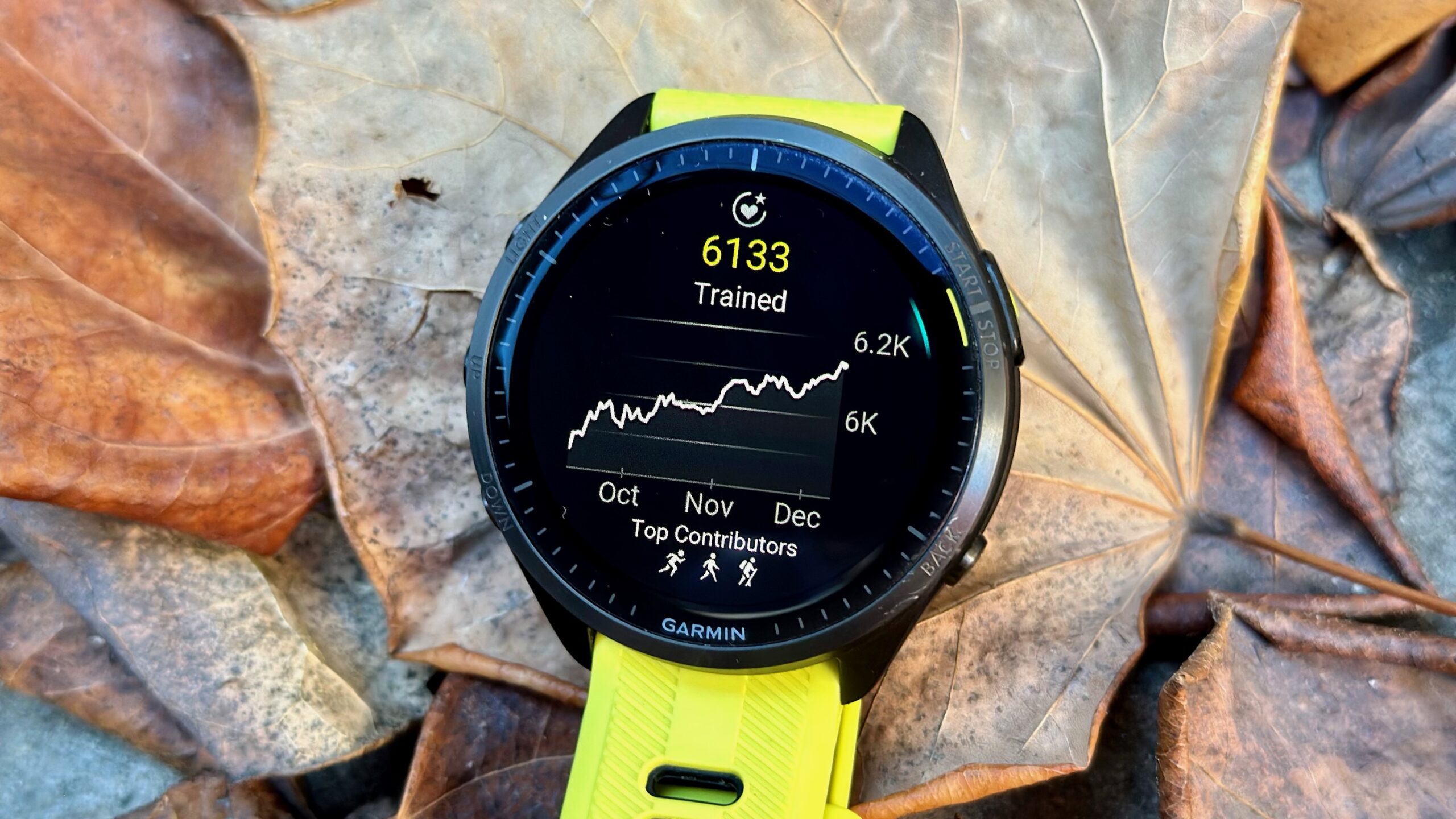
My favorite new additions to the Forerunner 965 are its Endurance and Hill scores. Hill score, as the name suggests, tests your endurance and strength when it comes to climbing up hills. The more you climb, the more likely your score will improve, showing how prepared you are for elevation-heavy races.
Endurance score, meanwhile, is a more advanced metric than VO2 Max, since “individuals with the same VO2 max often have very different results” according to Garmin. It looked at two to three months of training data to determine your individual “fatigue resistance” and “capacity to perform sustained efforts.” You can then check Garmin’s Endurance score chart to see how you fare against your gender and age group.
While the other Forerunner 965 exclusives gather proverbial dust, I do check my Hill and Endurance score charts to see how I’m improving over time, and find them quite useful.
Lastly, these are the 21 Forerunner 965 activity profiles that the 265 lacks: Swimming/Running, Indoor Climbing, Bouldering, Climbing, Golfing, Disc Golf, Road Biking, Gravel Biking, Bike Commuting, Bike Touring, Cyclocross, Kayaking, Motorcycling, Overlanding, Motocrossing, ATVing, Snowmobiling, Backcountry Snowboarding, Backcountry Skiing, Ice Skating, and Snowshoeing.
Of these, most are fairly niche motor, winter, or climbing sports for serious adventurers. Plus, you only need those specific biking profiles if you’re unhappy using the standard cycling activity for them. Most likely, it’s the Forerunner 965’s golfing tools — pre-downloaded course maps, yardage to green, digital scorecard, and other tricks — that will appeal to “everyday” athletes the most.
Garmin Forerunner 965 vs. 265: Which should you buy?
We have the Garmin Forerunner 265 listed as our best Garmin watch as of December 2023, simply because it strikes the right balance between training tools and affordability.
Make no mistake, the Garmin Forerunner 965 is significantly better, enough to justify spending $150 extra if your budget allows it — and should get even more high-end features over the next couple of years. The problem is that the Forerunner 265 already costs slightly more than your typical high-end Android watch or Apple Watch. It’s only “affordable” in that it has 90% of the tools of a Garmin Fenix or Epix, while weighing and costing far less.
Many runners don’t need maps, real-time stamina, non-running activity profiles, or Hill score data. An extra five hours of dual-frequency tracking (or 10 extra days of battery) and a titanium bezel are nice to have, but not strictly necessary to give your running a boost.
Don’t upsell yourself to the Forerunner 965 unless you (A) can truly afford it and (B) are a serious enough runner that you know you’ll be using it for years to come. Whichever you choose, you shouldn’t be disappointed.

Best running watch, period
Choose the Forerunner 965 for an all-around excellent experience, where the upsides of a larger, clearer display, better battery, and flagship features outweigh the negatives. Don’t choose it if you want a smaller watch or you can’t afford it.

90% of the same tools
Choose the Garmin Forerunner 265 if you want a reliable running watch with a bright AMOLED display, but can’t afford the 965. If battery life is a concern more than the display, you can always choose the Forerunner 255 for $100 less or the high-end Forerunner 955 for just $50 more.
